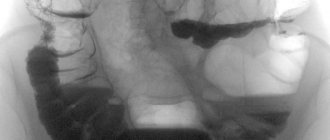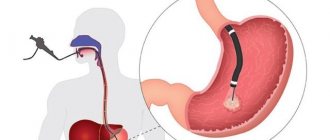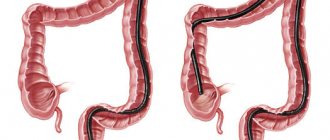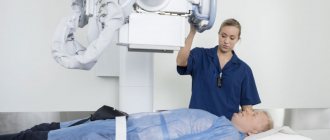Absorption of nutrients occurs in the intestine; the important role of this organ in the formation of immunity has also been proven relatively recently. In this regard, intestinal problems affect the general condition of the body and require immediate treatment. One of the diagnostic methods that makes it possible to identify many diseases is intestinal irrigoscopy.
What can be examined with intestinal irrigoscopy?
A healthy intestine on an X-ray with contrast has clear outlines with physiological bulges, it is evenly filled. What anatomical features of the organ are visible on x-ray, and what does intestinal irrigoscopy reveal?
Functional state of different parts of the intestine
In the intestine straightened with the help of liquid, it is clearly visible whether the appendix is able to function, how efficient the ascending colon and the descending rectum are, as well as the small intestine. Any pathologies will be immediately identified.
Size, location and diameter of the colon lumen
In the presence of abnormal narrowings and adhesions, the parameters of the colon lumen deviate from the norm. Irrigoscopy of the intestines gives an idea of their size and dislocation.
Elasticity and distensibility of intestinal walls
During irrigoscopy, the intestines are given a natural shape, and at the same time the elasticity of the walls is checked. The contrasting fluid that fills the intestines stretches its walls and shows where this function is impaired.
Condition of the intestinal mucosa
Thanks to the contrast, intestinal motility is visualized, as well as the condition of the mucous membrane and its relief. If the fullness is small, then only the internal relief is assessed. When it is strong, you can see abnormal changes, organ contours, inflammation, ulcers, tumors, etc.
Function of the intestinal valve
The intestinal valve is the part of the organ located between the ileum and large intestine. When functioning normally, the valve allows intestinal contents to flow in only one direction. During irrigoscopy, when the intestines are filled with contrast liquid, checking this parameter is not difficult.
X-ray examination of the intestine (irrigoscopy)
Irrigoscopy
is an x-ray method of examining the large intestine using a contrast agent, usually barium sulfate, administered through the rectum.
Irrigoscopy determines:
1. The shape, location and diameter of the lumen of the colon, 2. The extensibility and elasticity of the intestinal wall, the function of the bauginian valve (this is an intestinal fold located at the junction of the ileum and the colon. Normally, it allows intestinal contents to pass in only one direction - from the small intestine into the thick one, and if its function is impaired, there is a reflux in the opposite direction. During irrigoscopy, this is clearly visible from the movement of the contrast). 3. Functional state of different parts of the intestine 4. Relief of the mucous membrane. This indicator is crucial in the diagnosis of ulcerative lesions, diverticulosis, fistulas, tumors, as well as congenital malformations and cicatricial narrowings of the large intestine.
Irrigoscopy is a painless and non-traumatic procedure. Therefore, if there is a need for an X-ray examination of the large intestine, this technique is used.
Indications for irrigoscopy
Examination of the large intestine using irrigoscopy is used to clarify the diagnosis in the presence of the following complaints:
- Bleeding from the rectum;
- Copious mucous or purulent discharge from the intestines;
- Pain in the anus and along the colon;
- Chronic constipation or diarrhea;
- This method is also used if for some reason it is impossible to perform a colonoscopy or if questionable results are obtained during it. And another indication is a suspicion of an intestinal tumor in a patient with a family history or previously treated for this disease.
Contraindications to irrigoscopy
Irrigoscopy - the contraindications to which are not so numerous - is not performed in the following cases:
- In severe general condition of the patient, for example, with severe heart failure or tachycardia;
- If perforation of the intestinal wall is suspected;
- During pregnancy;
- Caution – in case of acute inflammatory bowel diseases (diverticulitis or ulcerative colitis).
Preparation for irrigoscopy
Like any other intestinal examination, the irrigoscopy procedure requires certain preparation. The colon must be free of feces so that filling with contrast is optimal, and the examination itself is informative: 2–3 days before the procedure, waste products are excluded from the diet, that is, those that cause bloating and heavy stool. It is forbidden to eat some porridges (barley, millet and oatmeal), greens and fresh vegetables (beets, carrots, cabbage, legumes), fruits (apricots, peaches, bananas, apples, oranges), and bread made from dark flour. Meat broths should not be rich, and it is recommended to steam or boil all dishes. The day before the examination, lunch should be light, it is not recommended to have dinner at all, and not to have breakfast on the day of the procedure. In addition to dietary restrictions, it is necessary to cleanse the intestines using enemas or special laxatives. A cleansing enema is done the day before the examination and in the morning on the day of the procedure. At one time, at least a liter of water is injected into the intestines and enemas are repeated until fecal impurities disappear from the rinsing waters. You can also cleanse the intestines with the help of special laxatives. Drugs such as Fortrans, Duphalac, Flit will help the patient prepare for the examination very comfortably and ensure high-quality irrigoscopy. They begin to be taken according to a certain schedule on the eve of the procedure and are completed in the morning on the day of the examination.
When is the procedure indicated?
Intestinal irrigoscopy is a complex examination that requires professional performance in a special diagnostic center with appropriate equipment. In addition, many patients find this x-ray procedure not the most pleasant, so only a doctor prescribes it if there is a justified need.
Discomfort and pain in the anal area
These symptoms can be caused by inflammation, as well as the presence of polyps and diverticula. Irrigoscopy of the intestines allows you to identify their dislocation and understand the causes of pain.
Bleeding from the rectum (hemorrhoids)
Hemorrhoids in themselves are not difficult to diagnose, but irrigoscopy allows you to identify the dislocation and size of hemorrhoids inside the rectum. This is the only way to find a complication of hemorrhoids in the form of thrombophlebitis. In the future, this will be a guide for the doctor when prescribing effective treatment.
Pathological discharge from the anus (mucus, pus)
The cause of discharge from the anus can be diverticula and ulcers, which are clearly visible in contrast. Also, intestinal irrigoscopy may show thickening of the walls, indicating tissue infiltration.
Persistent chronic constipation or diarrhea
Chronic constipation and diarrhea indicate a decrease or increase in intestinal tone. On x-ray they manifest themselves as an enlarged or reduced intestinal lumen. Also, intestinal irrigoscopy allows you to identify the cause of spasms.
What can't you eat?
- Bread
- Any sweets (even sweets of natural origin)
- Spicy, fried, salty, fatty or smoked foods
- Vegetables and fruits in their original form
- Mushrooms
- Greenery
- Canned foods
- Porridge (barley, oatmeal, etc.)
- Any fast food is strictly prohibited
- Spices and seasonings
- Carbonated drinks and alcohol
- Coffee and strong tea
- Legumes
- Cottage cheese
Diet
The patient preparing for barium enema should consist mainly of protein-rich foods:
- Chicken eggs
- Turkey, chicken and rabbit meat
- Semolina
- Fish meat (mostly white)
- Fermented milk products (yogurt, kefir)
- Green tea
Food should be taken at least 4-5 times a day in small portions. When preparing for the procedure, the volume of fluid consumed is of great importance. You need to drink a lot, about 2 liters of regular (still) water every day.
How to prepare properly?
The presence of feces in the intestines makes irrigoscopy difficult; preparation for the examination is mandatory. In order for the study results to be available for interpretation, it is very important to know how to prepare for intestinal irrigoscopy.
Diet
Preparation for intestinal irrigoscopy must begin 3 days in advance with a diet that prevents constipation and gas formation. The main diet should consist of dairy-free porridge, first courses, boiled vegetables and lean meat, eggs, fermented milk products, still water and unsweetened tea. Everything you can eat before irrigoscopy does not cause gas formation and is easily digested.
Colon cleansing (enemas, laxatives, etc.)
The day before the procedure, it is recommended to drink a laxative; castor oil (2 tablespoons) or a solution of magnesium sulfate (150 ml) is also suitable. After defecation, which usually occurs several hours later, you will need to do at least two enemas. In the morning before the procedure, it is necessary to do several enemas again until the intestines are completely cleansed before irrigoscopy.
2. Preparation for the procedure and how is it carried out?
Preparation for irrigoscopy
When preparing for a barium enema, be sure to tell your doctor if:
- you are allergic to latex or barium;
- You are pregnant;
- You have recently had a barium x-ray of your upper intestine, a colonoscopy, or a proctosigmoidoscopy.
When preparing for irrigoscopy, you should also know that it is necessary to completely clear the large intestine of stool and gas, because even a small amount can spoil x-rays.
You will have to not eat any food other than broths 2-3 days before the colon x-ray
. The day before barium enema, you need to drink plenty of clean liquids, take a laxative and do an enema with clean water. On the day of the colon x-ray, you may need to do the enema again.
How is irrigoscopy performed?
To x-ray the colon, it is necessary to fill it with barium solution. The barium suspension helps make the X-ray image clearer.
After your colon is filled, you will lie on a special table. The doctor will watch the barium solution move through your intestines on an X-ray fluoroscope screen. You may be asked to change positions so the contrast agent can penetrate deeper. Sometimes the doctor may also perform manual manipulation on your abdomen. If you have a double contrast barium enema, the barium will be removed from the colon and it will be filled with air.
After the rectal x-ray is completed, you will need to go to the toilet to get rid of excess barium. After this, the doctor will take a couple more x-rays.
Conventional fluoroscopy takes 30-45 minutes, although the time the barium suspension is inside is only 10-15 minutes. Irrigoscopy with double contrast takes about an hour.
Your stool may be white or pinkish for a day or two after the procedure. Drink as much fluid as possible to replace lost fluids.
Visit our Proctology page
Contraindications
Intestinal irrigoscopy is prescribed only if necessary, but in some cases it is contraindicated. Therefore, before the examination, an examination by a proctologist is required. He will decide whether the benefits of the procedure outweigh the harm from the side effects it causes.
During pregnancy
Intestinal problems during pregnancy are not uncommon. However, is it possible to do irrigoscopy during pregnancy? The answer is clear: no. X-rays by themselves are contraindicated for pregnant women, and filling the intestines with contrasting fluid can negatively affect the tone of the uterus. Therefore, during pregnancy it is better to find an alternative way to examine the intestines.
For pathologies of the cardiovascular system
Despite the complete painlessness of intestinal irrigoscopy, the patient experiences significant stress during the procedure. In severe pathologies of the cardiovascular system, the contrast agent can also cause damage to blood vessels. Therefore, irrigoscopy is undesirable for children.
In weakened patients in serious condition
A serious condition requiring bed rest can at least become an obstacle to intestinal irrigoscopy. This procedure puts a certain burden on the body, which is contraindicated in its weakened state.
If perforation of the intestinal wall is possible
If there is perforation of the intestinal walls, irrigoscopy can cause great harm to health, since contrast fluid from the intestine will enter the abdominal cavity. At the same time, the probability of a doctor’s error, although negligible, remains. If after the procedure there are sharp pains in the abdominal area, you must call an ambulance. The intestines may have been damaged.
How is the procedure performed?
During the procedure, the patient lies on an inclined table, on his side, with his arms folded behind his back and his legs bent. Through a special tube, 1.5-2 liters of a special contrast agent is fed into his intestines, most often barium sulfate plays its role. While the patient's intestines are filled with the necessary substance, doctors take x-rays. Then comes the next stage of the procedure, when the intestines are filled with air to smooth out its walls and examine its mucous membrane as accurately as possible.
Some doctors consider irrigoscopy to be a number of procedures dangerous to the human body. At the same time, clinical studies have not revealed the harmful effects of this examination on the body. During this procedure, the patient receives an acceptable dose of radiation, so barium enema does no more harm to the body than any other x-ray examination, such as x-rays of bones or the chest.
Women planning a pregnancy in the near future should approach this type of examination with a little caution.
Many people also ask the question: “Is it painful to do an irrigoscopy?” This procedure is in no way associated with pain; the maximum during such an examination is unpleasant sensations.
Preparation for irrigography with irrigoscopy
Preparation for irrigography with irrigoscopy begins on the eve of the study and consists of eliminating foods that contribute to gas formation from the diet:
- sweets;
- baking;
- wholemeal bread;
- vegetables rich in plant fiber (cabbage, zucchini, peas, carrots, beets, fresh herbs);
- fruits rich in plant fiber (plums, oranges, bananas, apricots, peaches, apples);
- whole milk.
Here is a list of only those products that most often interfere with the examination. Each person can have his own.
The day before and in the morning on the day of the study, cleansing enemas until “clean waters” are obtained.
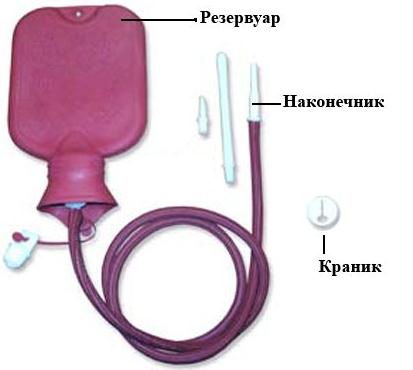
Fig. 1 Examples of cleansing enemas for children of different ages.
How is a cleansing enema performed:
Typically, the enema tip is administered to the child in the lateral position with the legs bent at the hip joints; but it is also possible in a supine position, with the legs leading to the stomach. The tip is inserted carefully, without violence, after generously lubricating it with Vaseline oil. The tip is inserted into the rectum of a newborn by 3 cm, a one-year-old child by 4 cm, and older children by 5 cm. The tip of the tip should be directed towards the sacrum after it passes the anal sphincter.
Depending on the age of the child, I use different volumes of liquid:
- Newborns – 30 ml
- 6 months – 90-100 ml
- 1 year – 200 ml
- 5 years – 300 ml
- 10 years – 400 ml
- 14 years – 500 ml
Reducing the water temperature to 22-24? enhances the laxative effect of the enema. If you have large and dense feces, it is useful to give an enema of Vaseline oil (about 30-50 ml) after the first cleansing enema and then a second cleansing enema. In addition to petroleum jelly, you can use sunflower and linseed oil. Vaseline oil enema is used, as a rule, for very hard stool. The amount of oil solution, if a pure oil enema is given, is approximately 2 times less than with a cleansing enema with water.
Have with you:
- Referral from a doctor
- Diaper
- Toilet paper or cleansing wipes
- Potty/diapers for small children
It is necessary to know the allergy history, i.e. whether your child has had allergic reactions in the form of hives, rashes, difficulty breathing when taking or administering any medicine.
Contraindications to the study are:
- Increase in body temperature on the day of the study
- Blood in the stool on the eve of the test
- Menstrual cycle in girls
You can eat it, but not in large quantities.
Pregnant, lactating women and people with thyroid disease are contraindicated in the office during the study!
Advantages and disadvantages of irrigoscopy
Irrigoscopy allows you to quickly and accurately diagnose the large intestine, including those sections into which endoscopic equipment cannot penetrate. Thanks to the contrast agent, which is evenly distributed throughout all parts of the intestine, the doctor receives a clear image in which large tumor formations and the anatomy of the intestine are clearly visible.
However, detecting an inflammatory process, a small polyp or a tumor at an early stage using irrigoscopy is difficult and often impossible.
